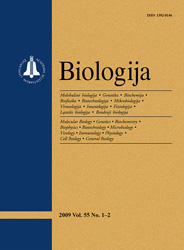Biologija / Biology
 ISSN 1392-0146 ISSN 2029-0578 (online) |
2006 m. Nr. 1 Assessment of genetic polymorphism in natural
populations of ostrich fern (Matteuccia
struthiopteris L., Dryopteridaceae) in Lithuania by
using RAPD markers
SRandomly amplified polymorphic DNA analysis was carried out to examine genetic diversity, population structure and polymorphism level among and within seven natural populations of ostrich fern (Matteuccia struthiopteris L., Dryopteridaceae) in Lithuania. In total, 43 plants were analysed using 10 polymorphic decanucleotide primers of random sequence. 73 polymorphic bands ranging in size from 470 to 2600 bp were derived using selected primers. The average value for Shannon’s phenotypic diversity index for all seven populations was I = 0.0498 (SD = 0.0534, P = 0.02), mean heterozigosity was 0.033 (SD = 0.038, P = 0.03), total gene diversity Ht = 0.3385 (SD = 0.0164), gene diversity among populations Gst = 0.9009 and gene flow Nm = 0.0550. PCA and UPGMA analysis revealed a high degree of interpopulation differentiation. Genetic differences among populations were due to the absence or presence of the same alleles in different populations, but not to the frequency of alleles in each population. Analysis of molecular variante (AMOVA) revealed that 9% of the total molecular variance was due to an individual variation within the populations and 91% to the differences among populations (ΦPT = 0.909, P = 0.001, df = 6). A weak but statistically significant correlation (r = 0.354, P = 0.047) between Nei’s genetic distances and the geographic location of populations was established using the Mantel test. The very low intrapopulation differentiation shows that clonal propagation is prevailing in populations of ostrich fern in Lithuania. The parameters of genetic diversity and a correlation of genetic distance with the geographic location revealed the existence of population isolation by distance forasmuch as migration is very low.
Keywords: clonality, genetic diversity, Matteuccia struthiopteris, RAPD, population genetic structure |
Issues:
2011 - Vol.57 No. 1, No. 2, No. 3 2010 - Vol.56 No. 1-4 2009 - Vol.55 No. 1-2, No. 3-4 2008 - Vol.54 No. 1, No. 2, No. 3, No. 4 2007 - Vol.53 No. 1, No. 2, No. 3, No. 4 2006 No. 1, No. 2, No. 3, No. 4 2005 No. 1, No. 2, No. 3, No. 4 2004 No. 1, No. 2, No. 3, No. 4 2003 No. 1, No. 2, No. 3, No. 4 2002 No. 1, No. 2, No. 3, No. 4 2001 No. 1, No. 2, No. 3, No. 4 |